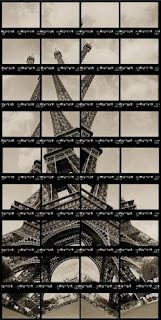Effel Tower 1911
Robert Delaunay (1885-1941) is seen as a pioneer of abstract art in the early 20th century and the inventor of Orphic Cubism. He was one of the most influential artists in Paris and very interested in the emotional effects of pure colour. He fused this interest in colour with the “loose geometry that he borrowed from Analytical Cubism” (Lynton, N., 2003 p.67) and used it to represent the modern city. Norbert Lynton suggests that “the large tilting planes in his paintings oppose and compensate for each other, each suggestion of space and movement being countered by another (2003 p.67).
The Red Tower 1911-12
For Delaunay the "master-image of culture was the Eiffel Tower, which he viewed with real ecstasy as an ecumenical object, the social condenser of a new age" (Hughes, 1991 p.36). He wanted, it was argued that Delauney "wanted a pictorial speech that was entirely of this century", the twentieth century, "based on rapid interconnection, changing viewpoints aand an adoration of 'good technology' and the Tower was the supreme practical example of this in the daily life of Paris" (Hughes, 1991 p.38).
Delaunay's "friend and collaborator, the poet Blaise Cendrars, remarked in 1924 that:
No formula of art known up to now can pretend to give plastic resolution to the Eiffel Tower. Realism shrank it; the old laws of Italian perspective diminished it. The Tower rose over Paris, slender as a hatpin. When we retreated from it, it dominated Paris, stark and perpendicular. When we came close to it, it tilted and leaned over us. Seen from the first platform it corkscrewed around its axis, and seen from the top it collapsed into itself, doing the splits, its neck pulled in...
(Hughes, 1991 p.38).
In works like The Red Tower 1911-12, "Delaunay could realize the sensations of vertigo and visual shuttling that Cendrars described. The Tower is seen almost literally, as a prophet of the future" (Hughes, 1991 p.38). For Deaunay the Tower "became his fundamental image of modernity: light seen through structure" (Hughes, 1991 p.38).
Dealuney's work has had a great impact on modern art and on the general vision of modernity. Here we have can see his studies of the Eiffel Tower and how they would go on to inform the work of Thomas Kellner.
Sources:
Hughes, (1991) The Shock of the New London: Thames and Hudson
Lynton, (2003) The story of Modern Art London: Phaidon





